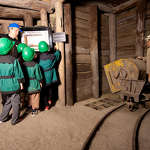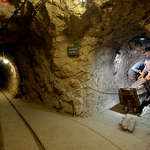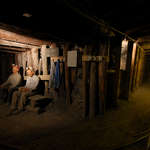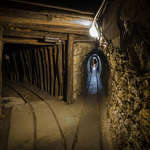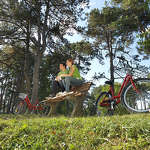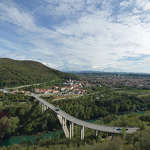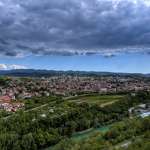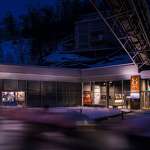
Slovenia and UNESCO
Despite being small in size, Slovenia hides a myriad gems to behold. Some of them were recognised by UNESCO and included in their Convention concerning the Protection of World Cultural and Natural Heritage. You will find underground caves, mines, women's handiwork and many other interesting features in this area that is small in terms of square kilometres but big in terms of experiences. The Karst is a phenomenon in and of itself, and its inhabitants are so specific that it behoves you to visit and chat with them. They will proudly greet you with excellent food, a kind word and a smile on their face.
OVERVIEW
DAY 1:
The last Bourbon king has his final resting place in Slovenia. His tomb and magnificent Bourbon Rose garden will take you back to a part of French history and show you how French kings were connected to Slovenian lands. Lace is a part of the Slovenian folk tradition that has been best preserved in Idrija. Bobbin lacemaking in Slovenia was officially entered on the UNESCO list of cultural heritage on 28 November 2018. You will be presented with the work done by the pupils of the Lace School (the summer break is in July and August so there are no visits then) and learn about the importance of lace for the town and the country at the Idrija Municipal Museum. Culinary enthusiasts will know that trying the excellent Idrija Žlikrof pasta, a culinary specialty of the area that enjoys European protection, is must when you come to Idrija. The dish is made of dough, filled with potato filling and formed into a characteristic shape. The famed Žlikrof pasta will energize you for the second leg of the day when you done the miner's garb for a day. There was once an active mercury mine in the town that now serves as a picturesque museum and offers fantastic experiences. The descent into the mine shaft and the visit to the smelting shop will show you the hard life of the miners and the importance of minerals for Slovenia throughout its history – a fact that was also recognised by UNESCO. Anthony's shaft from 1500 is famed for being one of the oldest preserved mine entrances in Europe, one of the oldest parts of the Idrija mine and the second largest mercury mine in the world. After the visit, you will take a drive to Nova Gorica and check in at the hotel where dinner is organised. If you're feeling lucky, you can visit a casino there.
DAY 2:
After breakfast, you will drive to the Karst region and its picturesque town of Štanjel, one of the oldest settlements in the Karst that is known for the oldest town centre where the architect Maks Fabiani left his mark between the two world wars. The town is situated on a hill and offers breathtaking views of the surroundings where farmers cultivate vineyards and make one of the best medicinal wines: kraški teran (Karst Terrano). You can try the wine and the Karst prosciutto for lunch that will be organised in the vicinity. In order to stay true to the UNESCO motif of the trip and go below ground again, you will descend into the Škocjanske jame caves that have been listed as a UNESCO natural heritage site since 1986. The park is located in the classical Karst and is a true open-air museum that is famed for surface and underground phenomena, rich archaeological finds, pioneering Karst exploration work and the rich natural and cultural heritage. The guided tour will begin at the Info Centre, proceed to the Globočak collapse doline and through an artificial tunnel into Tiha jama (Silent Cave), which is a fossil branch of the Škocjanske jame caves that is filled with stalactites and stalagmites. Upon exiting the cave, you will be mesmerised by the underground canyon of the Reka River that you cross over the Cerkvenikov most bridge rising some 50 metres above the river stream. You come to the surface at Velika dolina. After seeing the caves, you will be taken to the Lipica Stud Farm that was used over the course of its rich history by the Habsburgs to breed the Lipizzaner equine ballet dancers. A stroll through the park at the stud farm is a truly peaceful and inspiring experience.
PACKAGE PRICE PER PERSON
- Individually, with own transport: from 229 €
- VIP package with a guide and transportation: from 328 €
- Group trip: from 269 €
THE ADVENTURE/PACKAGE INCLUDES
- Visit to the Tomb of the Bourbons and the Bourbon Rose Collection
- Visit to the Idrija Town Museum – Lace Collection
- Visit to the Idrija Mercury Mine
- Sightseeing in Štanjel
- Visit to the Idrija Mercury Mine
- Visit to the Škocjan Caves
- 2 x lunch in the selected restaurant
- 1 x dinner
- 1 x overnight stay with breakfast at the hotel ****
For more information about trips and activities click here.
ADDITIONAL INFORMATION
- the program is available and runs from 1 April to 31 October, arrivals are possible every day of the week
- the program is intended for individual passengers, groups of 2–7 persons and larger groups for which the program can be adapted
- possibility to combine two or more packages
- tourist tax is included in the price
Hotel Perla ****
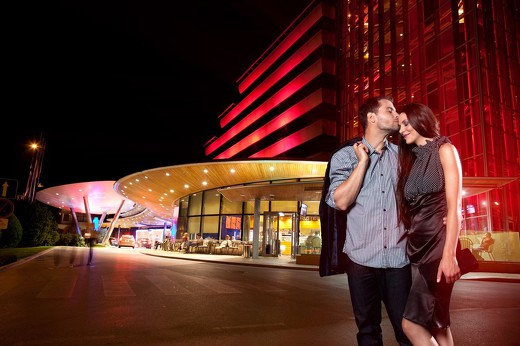
Hotel Perla is located in the centre of Nova Gorica. It is the biggest gaming and entertainment centre in Europe and a unique complex that gives one the feeling of being on an ocean liner.
You will be hard pressed to find a place that is so close to the sea and the Alpine peaks, the world-famous wine districts and mighty forests. Nova Gorica is surrounded by magnificent nature and heritage attractions, and is also an excellent starting point for a visit to the nearby Brda, the Soška dolina and Vipavska dolina valleys, plains, the Karst and much more. Are you up for some fun? Then you have come to the right place. Games of chance, themed evenings, DJs, lively concerts, dance and cabaret shows, dance club ... the fun never ends here.
Experience the unique sophistication and comfort of our hotel. Enter the world of beauty and wellbeing at the Perla Spa Center where you can relax and rejuvenate. Their approach is holistic and uses quality natural products. It is the biggest spa center in northern Primorska (1,000 m²). It offers a heated indoor swimming pool, 2 massage pools, Finnish, Turkish, bio and infrared saunas, a tanning salon, massages and various facial and body care treatments. A fitness centre is available for sports enthusiasts.
The hotel offers 225 spacious rooms and 24 apartments that are spacious, beautifully appointed and feature air conditioning, mini bar, a safe and satellite TV, including free WiFi.
The elegant Calypso restaurant serves Mediterranean flavours, local delicacies, excellent desserts and high-end Slovenian wines. The Mediterraneo restaurant offers breakfast and a wide assortment of past dishes. The Oceanis self-service restaurant offers meat, fish and vegetable dishes. The Dolce Vita coffee shop is an excellent place for your morning cup of coffee, cakes and ice cream.
Tomb of the Bourbons and the Bourbon Rose Collection

The tombs of the last members of the French royal family of the Bourbons can be found in the crypt of the church of Kostanjevica. Charles X came to the throne in 1824 as the third of the brothers (after the death of Louis XVIII). He was an autocratic ruler whose actions did much to increase conflicts with the parliament and in 1830 this brought about the so called July Revolution. The king was forced to give up the throne and together with the entire family left France. They first found refuge in Edinburgh, Scotland; from there they went to Prague, in the current Czech Republic. Finally they came to Gorica where they were received as the guests of Count Coronini. The reason they selected Gorica was probably mild climate as well as the fear of catching cholera raging all across Europe, but not in Gorica.
Seventeen days after their arrival in Gorica, Charles X aged seventy-nine died of cholera as the only victim of this disease then in Gorica. When he was ill in bed dying he was looking out the window and could see Kostanjevica. He expressed his wish to be buried in this monastery church. Thus, Kostanjevica is known as the “Little St. Denis” as all French Kings with the exception of three are buried in the in the Basilica of St. Denis north of Paris. Charles X is the only French king buried outside France and the only king buried in Slovenia. In addition to this last French king, several other members of the Bourbon family found their final resting places in the church crypt next to him being a symbol of power and glory of the royal dynasty.
In 2003, in cooperation with the Municipality of Nova Gorica, the Slovenian Rose Society with its head office in the town of roses, Nova Gorica, started to landscape a part of the kitchen garden made available by the monastery for the rose collection. A collection of old Bourbon roses was planted in the converted garden. Bourbon roses originated on the Île Bourbon (now called Réunion) off the coast of Madagascar and in the time of its origin the island was owned by the French royal dynasty, the Bourbons. These roses decorate the garden along the monastery church in the crypt of which the last King of France and his family together with the last heir to the throne rest.
Bourbon roses are the first link between briar-roses and modern-day roses. The change occurred almost two hundred years ago, in 1817, when a Chinese Old Blush and a European Damask Quatre saison accidentally interbred at Ile de Bourbon.
These roses bloomed all season, with pinkish colours and fragrances. They were revealed to the rest of the world in Paris in 1819 for the first time and again in 1821. Gardeners raised over 1500 different species through backcrossing. Most of them got lost and today the majority of the 80 species are preserved in the collection of our garden. And this collection grows every year.
Thus, the Rosary Garden in Kostanjevica is one of the largest collections in Europe and the world. Since Nova Gorica is a city of roses and has a stylized rose in its coat of arms, the Rose Festival is held in May every year. The main and most visited events take place among the Bourbon roses in the monastery garden.
Idrija Lace School

The Idrija Lace School has been a part of the Jurij Vega Secondary School in Idrija since 1974 and in 1992 it became a member of the international bobbin lace and needle lace organization- OIDFA.
The primary activity of the Idrija Lace School is the education of children in lace-making following the lace-making curriculum for children and young people as well as various adult target groups. A wide selection of quality handmade lace is also offered. The school is active through various activities and projects in Slovenia as well as in Europe, thus connecting with Slovenian and foreign lace-making centres. The head office of the School is in Idrija. The departments of the Idrija Lace School programme for children and young people are located in Idrija, Lower Idrija, Cerkno, Novaki, Ledine, Godovič, Črni Vrh nad Idrijo, Col, Podkraj and Vipava. Annually, the School is attended by about 400 children between the age of 6 and 15. To them the lace-making school is a free time activity to which they dedicate their time. Various forms of education for adults take place in Idrija and depending on the interest also in other places in Slovenia and abroad. In addition to education, the School offers a wide range of quality handmade lace and lace products, professional literature, materials and lace-making tools and patterns, pattern making and other related services. During school terms, the exhibition of the works by school pupils can be visited. The school is active through various activities and projects in Slovenia as well as in Europe, thus connecting with Slovenian and foreign lace-making centres.
Idrija Town Museum – Lace Collection

The Idrija Town Museum pays special attention to researching and studying Idrija lace. Over the years, an impressive collection comprising a broad range of items – lace pieces, bobbin lace patterns, textiles adorned with lace, lace sales catalogues, bobbin lace-making requisites (baskets, pillows, bobbins), and fashionable products decorated with lace has been created. The collection also includes archival materials related to bobbin-work (certificates, invoices, letters) and works of art inspired by lace. In past years, the Museum has enriched its collection with lace items and lace-making tools from other European lace-making centres, such as Milan, Genoa, Brussels, etc.
Anthony's Shaft in the Idrija Mercury Mine
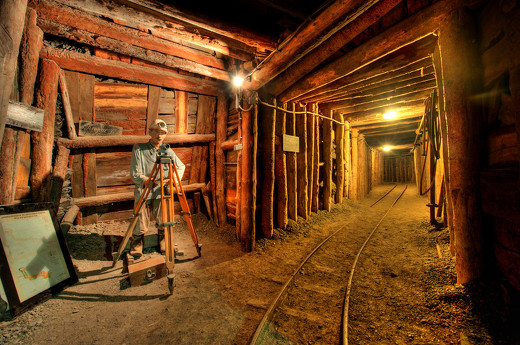
Anthony's Shaft was dug in 1500 and has been the oldest preserved entrance to a mine in Europe. Nowadays, it is a start of many visitors who wish to explore the underworld of the second largest mercury mine in the world. A guide takes you through underground tunnels to hidden corners with precious cinnabar ore and droplets of autochthonous mercury and the unique Chapel of the Holy Trinity. You will experience 240 million years of the geological past.
Idrija is a town with the longest mining tradition in Slovenia. Its history is intrinsically linked to 500 years of acquiring the precious metal – mercury. Mercury from Idrija played an important role in the development of world science, economy and medical science and was indispensable in the recovery of gold and silver by mercury amalgamation. The mine attracted most respected technical minds of contemporary Europe to Idrija and in conjunction with local experts they were the authors of technological and technical innovation important at the European level. The proceeds from the sale of mercury filled the coffers of monarchies and states which owned the mine in various periods.
After the mine was closed, extraordinary legacy of the 500-year mining has been preserved and recognised globally. In June 2012, the "Heritage of mercury" in Almadén and Idrija ", the two largest mercury mines in the world, were inscribed on the UNESCO World Heritage List. This is the recognition of the uniqueness and exceptionality of the work performed by generations of Idrija miners who created this heritage for almost half a millennium.
Hg Smeltering Plant
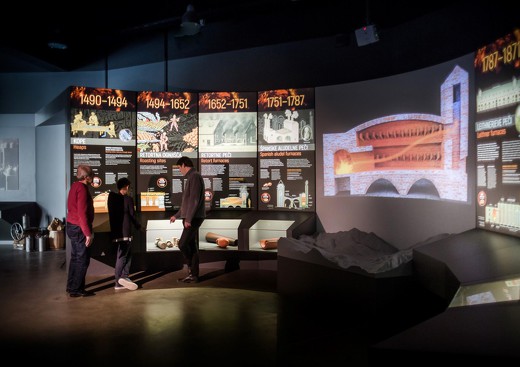
You will get to know the importance of this unique liquid metal that has changed the world through experiments, presentations, video clips and devices functioning on the basis of Hg. You will also be presented with its use in science, technology, medical science, culture and every-day life from prehistoric times to present. Hg Smeltering Plant also takes pride in the interactive exhibition and the largest rotary kiln for Hg in the world.
Mercury – Hg (hydrargyrium) is the only metallic element in Earth's crust that is liquid at standard conditions. When cooled down to -38.9°C, it becomes hard as steel and can be forged. Its boiling point is at 356.7°C. Because of its extraordinary density (1 litre of mercury weighs as much as 13.56 kg), the iron sphere can easily float on it. The usability of mercury has been versatile due to its properties – in the extraction of gold and silver, in medicine, cosmetics, dentistry, chemical and military industry and agriculture. Its uniform expansion was exploited in thermometers and its conductivity in electrical industry. The alchemists, however, were convinced that all metals came from mercury and sulphur and that these two elements could be used to make gold and the philosopher's stone.
Nova Gorica
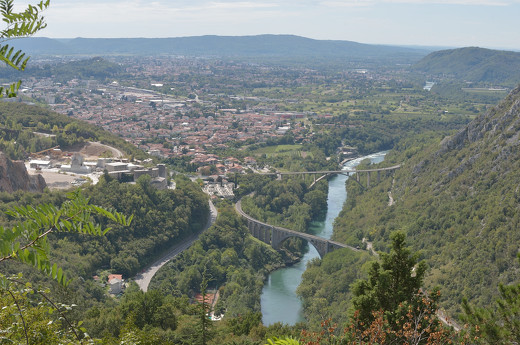
Nova Gorica, a small town along the border with Italy, has been the heart of the sunny Gorica region for seven decades. It has grown after the World War II as a substitute town for Gorizia, which remained on the other side of the border. It is a town with a mild climate, green and blooming all year round, young, lively and friendly to the local people and visitors from all over the world. Nova Gorica is a younger sister of Gorizia and together they are a unique example in Europe, the two towns are located at the border with no border crossings and in growing harmony at all levels.
Nova Gorica is a town of roses. It is attractive and offers numerous opportunities for entertainment in all seasons with various venues, indoors or outdoors, and a rich selection of events. Concerts, festivals, theatre performances, fairs, exhibitions and other cultural, culinary and ethnological events enrich the lives of the locals and guests. Nova Gorica is a gaming town where two entertainment centres and several casinos offer entertainment with the most modern gaming equipment. A pleasant atmosphere is complemented by excellent cuisine, accommodation and wellness services. Nova Gorica is the right place to see the sights and experience attractions of the town and its surroundings in a genuine way.
In the northeast, Nova Gorica is protected from cold winds by the Trnovo and Banjšica Plateau, a marvellous world with a completely different climate, full of folk traditions and natural attractions which in a special way enrich the hiking destinations. Lovers of peace will be impressed by the widespread Trnovo Forest which invites you to take biking paths and hiking trails where one can get to know rich fauna and flora. Those interested in flora will enjoy visiting the Herbal centre in Grgarske Ravne where they will become familiar with the production, processing and use of medicinal herbs.
The green and wine-growing Vipava Valley stretches out to the eastern part of the town. These nice places are the home of great wines, also of the unique varieties such as »zelen«, »pinela« and »klarnica« that go well with tasty dishes of Vipava.
- H1 Hotel Perla ****
- 2 Tomb of the Bourbons and the Bourbon Rose Collection
- 3 Idrija Lace School
- 4 Idrija Town Museum – Lace Collection
- 5 Anthony's Shaft in the Idrija Mercury Mine
- 6 Hg Smeltering Plant
- 7 Nova Gorica
-
- VIP tour with tourist guide and transportation
- Group trip
-
No. of peopleConfirm
Transfer from the airport
Guests arriving by air will be offered comfortable transfers at competitive prices from close by airports. Our chauffeur will meet you at the arrival and will bring you back safely and on time
to the airport at the departure. You can cancel the transfer from your home to the hotel without expenses within 72 hours prior to scheduled transfer. You will receive the information about the exact time of departure a day before the scheduled transfer.
-
From - to:
-
Distance:km
-
Travel time:h
-
Type of transfer:One-way transfer
-
Price:€ per person
-
Number of people:
-
From - to:
-
Distance:km
-
Travel time:h
-
Type of transfer:Return transfer
-
Price:€ per person
-
Number of people:
Transfer from home to the hotel
Guests from northern Italy are offered the possibility of transport from home to the hotel. You can choose between
morning or afternoon directory term, the carriage is available for 2-7 passengers, reservation up to 5 days prior to departure. The notice of the exact time and location of departure one day prior to the tour.
-
From - to:BENETKE - MORAVSKE TOPLICE
-
Distance:km
-
Travel time:h
-
Type of transfer:One-way transfer
-
Price:€ per person
-
Number of people:
-
From - to:BENETKE - MORAVSKE TOPLICE
-
Distance:550 km
-
Travel time:5,5h
-
Type of transfer:Return transfer
-
Price:€ per person
-
Number of people:
Holidays in Slovenia portal.
You will receive an automatic reservation recapitulation on your e-mail address,
final confirmation will be sent upon payment.
You will receive an update on your reservation within 2 hours; if not, please, call us as soon as possible or send e-mail. Also check SPAM.
Thank you for your confidence and best regards.
HolidaysinSlovenia.eu




